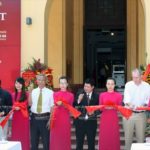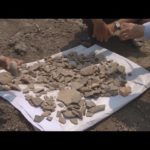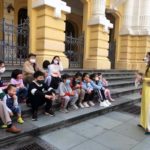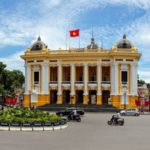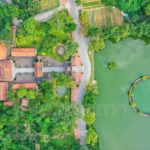The exhibition named “Am vang Dong Son” or “Dong Son Echoes from the Past” is currently being showcased at the Vietnam National Museum of History and will run until the end of April 2024.
| The Dong Son bronze drum, cast in 2022, is said to be 80% similar to the prototype. Photo: VOV2 |
The main purpose of this exhibition is to commemorate Vietnam’s Heritage Day (which falls on November 23) and to celebrate the centenary anniversary of the discovery of the Dong Son culture.
According to Nguyen Van Doan, the Director of the Vietnam National History Museum, the Dong Son culture has played a significant role in the development of Vietnam’s history. The name “Dong Son” was given to this culture by archaeologists based on the accidental findings of several ancient bronze artifacts, dating back approximately 2,000 years, in 1924 in Dong Son Village, located on the banks of the Ma River in Thanh Hoa Province.
Doan further emphasized that “Dong Son archaeological artifacts from the Bronze Age, spanning from 1000 BC to the first century AD, are characterized by their immense richness, diversity, and extraordinary aesthetic appeal.”
These artifacts, including tools, household utensils, weapons, musical instruments, and jewelry, were skillfully crafted using materials such as copper, iron, ceramics, glass, wood, and stone. The brass artifacts, in particular, display exceptional craftsmanship and technical proficiency.
The exhibition is divided into three distinct sections: “The newly unveiled materials related to Dong Son culture,” “Dong Son drum mold discovered from Luy Lau underground,” and “Experimental Dong Son bronze drum casting.”
| Visitors to the thematic display entitled Dong Son Echoes from the Past at Vietnam National Museum of History. Photos: VOV2 |
At the exhibition, attendees can explore the outcomes of extensive archaeological research conducted by the Vietnam National History Museum in collaboration with the National Museum of Korea and East Asia University (Japan) at various significant archaeological sites, including Dinh Trang (Hanoi), Bai Coi (Ha Tinh Province), and Luy Lau ancient citadel in Bac Ninh Province.
Notably, in the Luy Lau Citadel in Thuan Thanh District, Bac Ninh Province, thousands of fragmented bronze drum molds were recently discovered, dating back to the 2nd century AD. This remarkable finding reinforces the enduring prominence of the Dong Son culture and contributes to unraveling the mysteries surrounding the ancient Vietnamese’s bronze drum casting techniques, which date back approximately 2,000 years.
Thus far, Luy Lau is the only known archaeological site globally where such extensive fragments of the Dong Son drum mold have been found. Prior to this discovery, a single piece of the mold was unearthed on the citadel’s surface in 1998, while another piece was found deeply buried beneath the wall in 2001.
Significantly, this showcase at the Vietnam National History Museum features the first scientifically replicated bronze drum, which stands as an impressive 80% faithful representation of the original.
| Artifacts on display at the exhibition. |
Between the years 1964 and 1975, the Vietnam Museum of History, in collaboration with the Vietnam Museum of Fine Arts, experimented with several bronze drum replicas. These replicas were based on the analysis of alloy composition and technical traces found on artifacts.
However, their initial four attempts at casting were unsuccessful. It wasn’t until 2022 when the fifth casting, carried out in Thieu Hoa District, Thanh Hoa Province, at the Che Bronze Casting Village, turned out to be the most successful, with an astounding 80% resemblance to the original prototype.
Nguyen Thi Thu Hoan, Deputy Director of the Vietnam National History Museum, affirmed that these bronze drum casting experiments enable scientists to gain a deeper understanding of the advanced techniques employed by the ancient Dong Son people. The successful casting, using only fragments of the drum mold, showcases the dedication and scholarly endeavors of local scientists, archaeologists, and craftsmen from this age-old traditional village.
Remarkably, even after the passage of several millennia, the techniques utilized in the casting of these large ancient bronze drums, adorned with intricate patterns, continue to be veiled in mystery.
| The Dong Son Echoes from the Past exhibition helps visitors better understand the Dong Son culture. |
|
The Dong Son culture, also known as the Lac Viet culture (named after the village of Dong Son), emerged as a prominent Bronze Age civilization that thrived in ancient Vietnam. This culture was centered in the Red River Delta, located in the northern regions of the country, and thrived from 1000 BC to the 1st century AD. The Dong Son drums stand as undeniable evidence for the origins and technical expertise possessed by the ancient people who inhabited this region during the Dong Son culture’s reign. The Dong Son culture evolved from the earlier Go Mun culture and represented the pinnacle of the Bronze Age and the beginning of the Iron Age. These bronze drums, in addition to their ceremonial significance in warfare, mourning, and festivities, played a crucial role in summoning warriors by their reverberations when struck during tribal gatherings. The intricate scenes depicted on the drums portray various aspects of a society in Dong Son, including drummers and other musicians, warriors, rice processing, birds, deer, war vessels, and geometric patterns. The Dong Son bronze drums are the epitome of “remarkable skill.” For instance, one drum, discovered near Co Loa on the outskirts of Hanoi, weighs 72 kilograms and required melting between one and seven tons of copper ore. |





